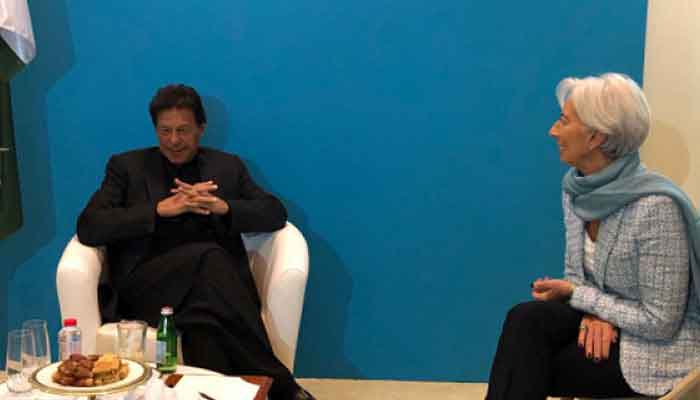‘Pakistan, IMF agree on policy direction’
SBP Governor said investment commitments made by Pakistan’s friendly countries have given the country some cushion to withstand external headwinds, and “also bode well for growth and employment opportunities”. “The foremost step required is to arrange external funding to meet the financing gap.”
Highlights
- Pakistan and IMF have generally reached an agreement over the bailout program
- SBP Governor: current account deficit is likely to narrow further
- The economy is going through a phase of transition: Bajwa
KARACHI: Pakistan and International Monetary Fund (IMF) have generally reached an agreement over the bailout program to meet the financing gap, but timing and pace of stabilisation policies are under discussion, SBP Governor said on Monday.
“There is a general agreement regarding the policy direction between us and the IMF; the differences are only on the timing and pace of stabilisation policies,” Governor State Bank of Pakistan (SBP) Tariq Bajwa said. “The government is continuously negotiating to get a program that can avoid a hard landing for the economy.”
Bajwa was addressing the Bloomberg Pakistan Economic Forum, a statement said.
SBP Governor said investment commitments made by Pakistan’s friendly countries have given the country some cushion to withstand external headwinds, and “also bode well for growth and employment opportunities”. “The foremost step required is to arrange external funding to meet the financing gap.”
Bajwa said current account deficit is likely to narrow further on the back of a deceleration in imports of goods and services and robust workers’ remittances. “The early-harvest CPEC (China-Pakistan Economic Corridor) projects aimed at eliminating structural bottlenecks in the economy are near completion.” Current account deficit declined 22.6 percent year-on-year during the first eight months of FY2019 and was only $356 million in February.
SBP Governor said it will be challenging to achieve sustainable high growth without high savings, increasing revenue generation and reducing trade gap in the economy that experienced “a spell of rising GDP growth between FY2014 and FY2017”.
“Pakistan’s economy is set for a calibrated moderation (as) a result of the high fiscal and CAD (current account deficit), which was registered in FY2018,” he said. “The economy is going through a phase of transition. Stabilisation policies are in place to ensure a stable macroeconomic environment, which is vital for economic development. Bajwa, however, said the government is pursuing wide-ranging reforms to improve the ease of doing business in the country and minimise the cost of stabilisation measures.
SBP Governor said the economy must brace for an initial slowdown before it gets back on the recovery track. The consumer price inflation is projected to fall in the range of 6.5 to 7.5 percent for FY2019. CPI inflation for February has reached 8.2 percent, with July-February average inflation at 6.5 percent. Raw material costs for businesses have moved up because of higher oil prices and exchange rate depreciation, and financing cost has also escalated. “The correction in the exchange rate shall make production in many sectors more competitive and encourage new ventures in import substitution,” he said. “The market-driven PKR (rupee) depreciation has allowed the domestic goods and services to compete more favourably in the international markets.” The rupee has moved 31 percent against the dollar since January 2018.
SBP Governor underscored a need for taking the tax-to-GDP ratio to at least 15 percent. “Without this a primary and revenue surplus will be a mirage,” he said.
-
 Bruce Springsteen Makes Strong Political Statement
Bruce Springsteen Makes Strong Political Statement -
 Prince Harry Relationship With King Charles 'not Straightforward,' Says Expert
Prince Harry Relationship With King Charles 'not Straightforward,' Says Expert -
 Truth Behind Jennifer Lopez's 'rude' Glambot Moment Laid Bare
Truth Behind Jennifer Lopez's 'rude' Glambot Moment Laid Bare -
 Nicole Richie Still Loves This Makeup Trend From Her Teen Years
Nicole Richie Still Loves This Makeup Trend From Her Teen Years -
 Meghan Markle Plans To Hide Behind Kids Over Return To UK
Meghan Markle Plans To Hide Behind Kids Over Return To UK -
 Dolly Parton Marks Major Milestone As State Governor Honors Her Legacy
Dolly Parton Marks Major Milestone As State Governor Honors Her Legacy -
 Karley Scott Collins Reacts To Rumours Of Her Dating Keith Urban
Karley Scott Collins Reacts To Rumours Of Her Dating Keith Urban -
 Meghan Markle Sends Shockwaves With Promise Of Chaos: ‘Has The Power To Upset The Royals’
Meghan Markle Sends Shockwaves With Promise Of Chaos: ‘Has The Power To Upset The Royals’ -
 Jesy Nelson, Zion Foster Call It Quits Amid Twins' Heartbreaking Diagnosis: Source
Jesy Nelson, Zion Foster Call It Quits Amid Twins' Heartbreaking Diagnosis: Source -
 What King Charles Told Princess Diana In Letter Before Wedding?
What King Charles Told Princess Diana In Letter Before Wedding? -
 David Crosby Said This One Singer Had 'no Talent At All'
David Crosby Said This One Singer Had 'no Talent At All' -
 Meghan Markle’s Return Risks Setting Off Something ‘exhausting’ And William, Kate Are Bracing
Meghan Markle’s Return Risks Setting Off Something ‘exhausting’ And William, Kate Are Bracing -
 Bruce Springsteen Reveals Singer He Finds To Be Greatest Rock And Roll Voice
Bruce Springsteen Reveals Singer He Finds To Be Greatest Rock And Roll Voice -
 Andrew Mountbatten Windsor Ensures Teddy Bear Collection Reaches New Home
Andrew Mountbatten Windsor Ensures Teddy Bear Collection Reaches New Home -
 Ben Affleck Recalls 'throwing Up' During 'Armageddon' Final Scene
Ben Affleck Recalls 'throwing Up' During 'Armageddon' Final Scene -
 Kevin Costner Marks 71st Birthday With Decades-old Throwback Photos
Kevin Costner Marks 71st Birthday With Decades-old Throwback Photos




